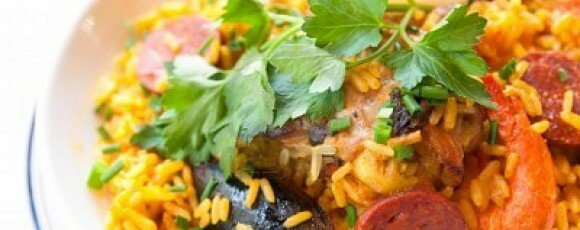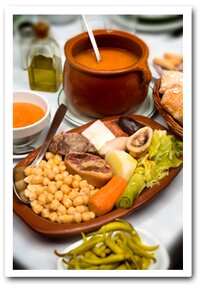
Madrid as the capital of Spain, is a melting pot of different dishes from all parts from the country. Among them, the Cocido Madrileño is probably one of the most famous dishes: a stew combining chickpeas with vegetables (cabbage, celery, carrots, turnips and potatoes) and chicken, beef and pork (chorizo) and which is turned into a huge succulent stew. Make sure you plan a siesta in afterwards as you probably hardly can stand up from your chair after eating this hearty dish.
Callos or tripe is another one of the typical local dishes and can be found on a lot of daily menus in the city’s restaurants. The texture is rather gummy and you should only try this dish if you are used to eating unusual plates and are not picky about your flavours.
The savoury Sopa de Ajo(garlic soup) is a rather surprisingly tasty soup. Invented out of poverty, this soup was made with old bread and chicken broth when times were hard. Now in modern times, an egg normally is added to the soup as well, which makes it an interesting tasty soup. We do recommend not eating this soup before going on a date though.
Another famous Spanish and typical dish is the famous tortilla de patatas (potato omelette). Legend has it was Carlist general Tomás de Zumalacárregui who, during Bilbao’s siege, created the “Tortilla de Patatas” as an easy, fast and nutritive dish to satisfy the dearth of the Carlist army. Although it remains unknown whether this is true, it appears that tortilla starting to spread during early Carlists’ wars.
There are many variants for this dish, and almost every Spanish home has its own favourite way of preparing tortilla. Some of the many additions to the base ingredients include: green peppers, chorizo, courgettes, aubergines, mushrooms, or diced ham. In Madrid though the only extra ingredient you normally find are onions.
Madrid’s sweet tradition can be appreciated through its desserts; from torrijas (slices of bread soaked in milk and fried in olive oil), typical consumed during semana santa (Holy week), to the barquillos (rolled wafers), and the buñuelos (a type of fritter filled with custard whipped cream and sugar.) Before and during Christmas you can find mazapán (marzipan) and turrón (soft and hard nougat) everywhere and the rosquillas de anis are eaten (anise-flavored doughnuts) during the festival of San Isidro in May when everybody dresses up as “chulapos” and “chulapas”.
In Madrid, as well as in the rest of Spain, the tapa (savoury titbits of a variety of dishes served as appetisers) is an old gastronomic tradition. You can find numerous establishments specialised in serving these tapas. “Ir de tapeo” (going out for tapas) is a tradition; hundreds of bars scattered throughout the streets of Madrid serve a tapa accompanied by a small glass of wine or beer. We highly recommend creating your own tapas tour in the Madrilenian centre, one of the best ways to get to know Madrid in a fun way!
Join our Spanish language school in Madrid and taste for yourself.




